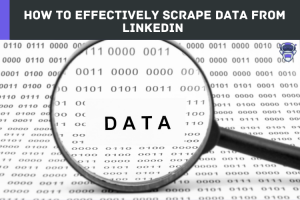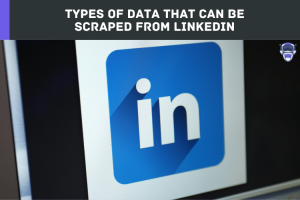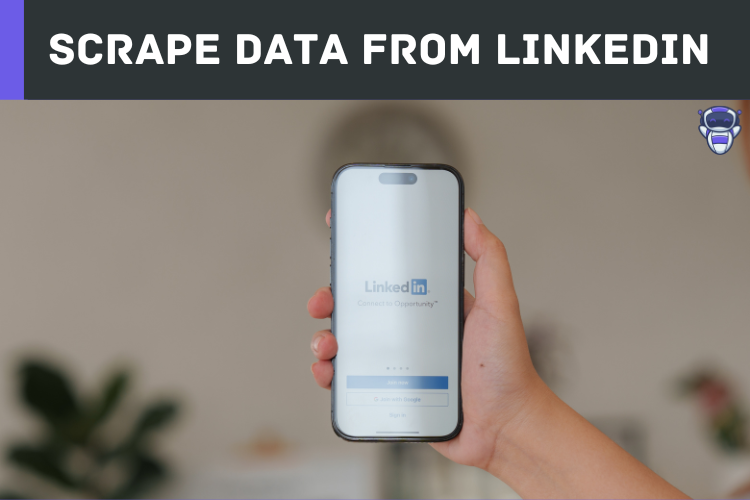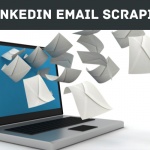LinkedIn data is vitally important for marketing and business growth. Learn how to scrape it effectively in order to unlock hidden insights.

LinkedIn is a professional networking platform with over 740 million members worldwide, making it a treasure trove of data for businesses and organizations. However, extracting valuable insights from this massive data pool can be daunting. This is where LinkedIn data scraping comes in. LinkedIn data scraping is extracting data from LinkedIn profiles, pages, and groups to gain insights into a company, industry, or market.
In this article, we will explore the basics of LinkedIn data scraping, the types of data that can be scraped, best practices for effective scraping, and strategies for using the data. We will also examine the challenges and risks involved in data scraping and discuss how to mitigate them. By the end of this article, you will better understand how to effectively scrape data from LinkedIn and unlock hidden insights for your business or organization.
Contents
Understanding LinkedIn Data Scraping
What is LinkedIn Data Scraping?
LinkedIn data scraping is extracting data from LinkedIn profiles, pages, and groups using automated tools or software. This data can be used for various purposes, such as market research, competitor analysis, lead generation, and recruitment.
The data that can be scraped from LinkedIn includes personal information such as name, location, education, and job history, as well as professional information such as job title, company, and industry. Engagement metrics such as likes, comments, and shares can also be scraped from LinkedIn to gain insights into the popularity of certain topics or posts.
It is important to note that while LinkedIn data scraping can provide valuable insights, it is a controversial practice due to privacy concerns and legal and ethical considerations. Therefore, it is crucial to understand the risks and best practices associated with LinkedIn data scraping before embarking on such activities.
Scrape Data from LinkedIn? How Does it Work?
LinkedIn data scraping typically involves the use of automated tools or software that extract data from LinkedIn profiles, pages, and groups. There are several scraping tools available in the market, including both free and paid options.
The scraping process usually involves the following steps:
-
Defining the search criteria:
This involves specifying the search parameters such as location, industry, job title, or keywords.
-
Collecting the data:
Once the search criteria are defined, the scraping tool will start collecting data from LinkedIn profiles, pages, or groups that match the search parameters. The tool will extract data such as name, job title, company, location, education, and any other relevant information.
-
Cleaning and preparing the data:
The data collected from LinkedIn may contain errors or duplicates, which need to be cleaned and organized before analysis. This process may involve removing duplicates, standardizing data, and filtering out irrelevant information.
-
Analyzing the data:
The final step involves analyzing the data to identify patterns, trends, and insights that can inform business decisions.
It is important to note that LinkedIn data scraping is against LinkedIn’s terms of service, and the company has taken steps to prevent or restrict data scraping activities on its platform. Therefore, it is crucial to ensure that the data scraping activities comply with all applicable laws and regulations.
Types of Data that Can be Scraped from LinkedIn

The types of data that you can scrape from LinkedIn are:
-
Basic information:
This includes a user’s name, job title, location, education, and work experience.
-
Contact information:
If a user has made their contact information public, it may be possible to scrape their email address, phone number, or other contact details.
-
Skills and endorsements:
Users can add skills to their profiles and receive endorsements from other users. This information may be useful for identifying professionals with specific skills or areas of expertise.
-
Groups and associations:
Users can join groups and associations related to their industry or interests. This information may be useful for identifying individuals with similar interests or for networking purposes.
-
Connections:
LinkedIn users can connect with other users, and the connections may be visible on their profiles. This information may be useful for identifying potential business partners or for understanding a user’s professional network.
How to Choose the Right Data Scraper?
When choosing a data scraper, there are several factors you should consider to ensure that it is the right one for your needs. Here are some key considerations:
-
Purpose:
Determine what kind of data you need to scrape and what you want to do with the data once you have it. This will help you choose a data scraper that is best suited to your specific needs.
-
Ease of use:
Consider how user-friendly the data scraper is. Look for a scraper with an intuitive interface and straightforward setup process.
-
Performance:
Evaluate the scraper’s performance. Consider factors like speed, accuracy, and the ability to handle large amounts of data.
-
Customization:
Look for a scraper that allows you to customize your scraping parameters to meet your needs. This includes the ability to select which data to extract, the format in which to receive it, and how frequently to scrape the data.
-
Price:
Consider the cost of the data scraper. Look for a tool that provides good value for money and fits within your budget.
-
Legal compliance:
Make sure the scraper you choose complies with relevant laws and regulations, such as data privacy and copyright laws.
-
Support and documentation:
Look for a data scraper with good customer support and documentation. This can include a user manual, tutorials, and a responsive support team to help you with any issues or questions you may have.
List of top 5 Best LinkedIn Data Scrapers:
- Phantombuster
- Captain Data
- LinkedIn Leads Generator
- Waalaxy – Prospectin
- Dux-Soup (Turbo)
Conclusion
LinkedIn data scraping can provide valuable insights and opportunities for businesses and individuals. It is important to note that data scraping must be conducted ethically and in compliance with LinkedIn’s terms of service and relevant laws and regulations. It is also important to ensure the accuracy and relevance of the data collected and to use it in a way that respects the privacy and preferences of the individuals whose data is being scraped.



… [Trackback]
[…] There you will find 77915 additional Information on that Topic: blog.leadstal.com/scrape-data-from-linkedin/ […]
… [Trackback]
[…] Find More here to that Topic: blog.leadstal.com/scrape-data-from-linkedin/ […]
… [Trackback]
[…] Find More Info here on that Topic: blog.leadstal.com/scrape-data-from-linkedin/ […]
… [Trackback]
[…] Read More to that Topic: blog.leadstal.com/scrape-data-from-linkedin/ […]
… [Trackback]
[…] There you can find 36789 more Information on that Topic: blog.leadstal.com/scrape-data-from-linkedin/ […]
… [Trackback]
[…] Read More to that Topic: blog.leadstal.com/scrape-data-from-linkedin/ […]
… [Trackback]
[…] Find More Info here on that Topic: blog.leadstal.com/scrape-data-from-linkedin/ […]
… [Trackback]
[…] There you can find 52946 more Information on that Topic: blog.leadstal.com/scrape-data-from-linkedin/ […]
… [Trackback]
[…] Find More on on that Topic: blog.leadstal.com/scrape-data-from-linkedin/ […]
… [Trackback]
[…] Read More on on that Topic: blog.leadstal.com/scrape-data-from-linkedin/ […]
… [Trackback]
[…] Find More here on that Topic: blog.leadstal.com/scrape-data-from-linkedin/ […]
… [Trackback]
[…] There you can find 12608 additional Info on that Topic: blog.leadstal.com/scrape-data-from-linkedin/ […]